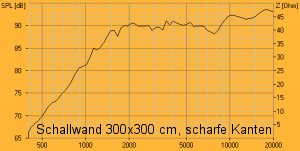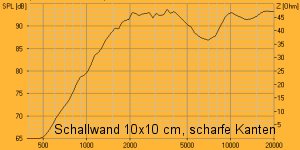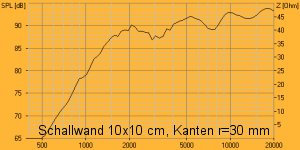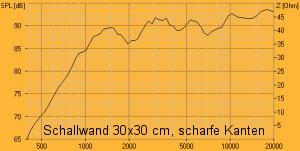[Products]
[Press + Media]
[Basics]
[Technology]
[Application]
[Shop]
[FAQ]
[Contact]
[Links]
[Site Notice]
Reflections determine any sound radiation in relevant ways.
Reflections in a driver, for example in the basket or the motor, have a great influence on frequency response and distortions. Also within the housing, reflections make mistakes in frequency response and a delayed decay at certain frequencies, dependent on the housing dimensions.
Und schließlich können Reflexionen und Kanteneffekte im direkten äußeren Umfeld des Chassis einen hohen Einfluss auf dessen akustische Eigenschaften haben. Finally, reflections and effects of the edges in the close environment can have big influences on the acoustical properties of a driver.
To make it clearly, here you can see a little comparison of always the same (very good) tweeter in different surroundings the measurement is always done on axis:





You can see clearly now: the frequency is deformed more or less by the surroundings. Here we have big influences by the dimensions of the baffle, the position of the driver in the area and the kind of the edge of the bafflel
Here you can see that a simple comparison between individual tweeters and those that are already integrated into a cone driver, is more than unfair, it is simply misleading:
A single tweeter is usually to be measured in an idealized " infinite" baffle (DIN 165x135 cm with well-defined position of the subjects) without disturbing influences of the environment from the outside. When comparing individual tweeters, this method also makes sense because a comparability of different drivers is guaranteed. It doesn´t say much of the behaviour of a perfect (in this environment) driver with a perfectly linear performance – we have to look for the behaviour in the real environment
The tweeter of a coaxial system, however, brings at least something of his later environment with him even if the entire coaxial speaker is placed in a infinite baffle. The influence of the baffle is the bigger, the closer the area surrounding is to the tweeter itself. And just this next area,(in case of the coaxial tweeter: the surrounding woofer), is already included in the measure in this case. In comparisons , the wavy frequency response (on axis) of tweeters in coaxial systems is considered as a disadvantage, while we simply forget that even state of the art tweeter systems in real installation conditions doesn´t react different - only in the idealized test environment. They seems to have a linearity without blemish.
Nevertheless, for the development of a coax driver (which is as near as possible to a ideal point source),we have to consider the following:
- A minimum reflective surface behind the woofer, realized through lean and streamlined struts and a possible lean engine. Who watched once the motor (magnet-system) from traditional drivers, will soon understand that it can not be a good idea “to shut” almost the entire cone area in the back with a solid wall
- Minimizing any rough edges around the tweeter. Here we can get benefits by the border of the basket , especially viewing of subsequent actual use conditions. Often the mounting holes for the screws don't allow to make them acoustical invisible - why?
- The design of the surround, which is often seen by the tweeter as a wall or moat can be optimized for this use.
- Finally, we must make the transition from the tweeter to the woofer and also the cone of the woofer itself so that they have as little negative influences as possible to the sound of the tweeter. Surely sharp edges and in front of the tweeter vibrating hoppers are not the right way.
In the construction of a driver, hundreds of parameters influence each other. If you change one, this has a direct effect on the others. The art is to harmonize all these results as perfectly as possible, to minimize the inevitable compromises and to take the best result in the total. Not for the endless sound wall, but for the real speakers, which have to be realized with the driver in effect.
Copyright(c) 2018 Audio Consequence. Alle Rechte vorbehalten.